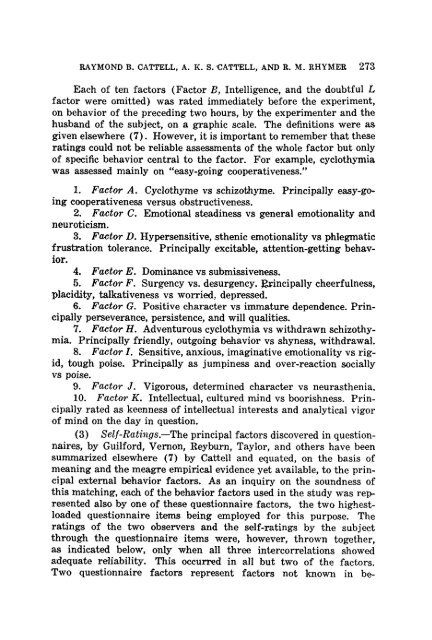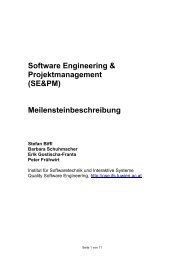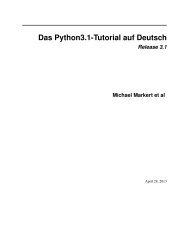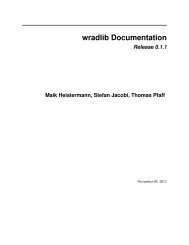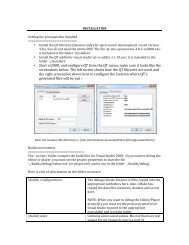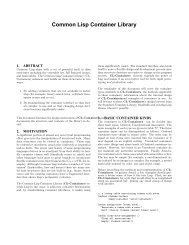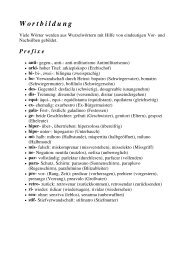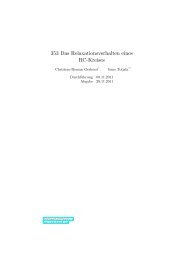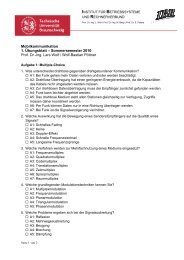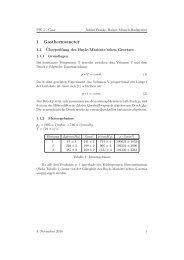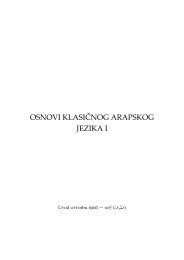P-Technique Demonstrated in Determining ... - Bitbucket
P-Technique Demonstrated in Determining ... - Bitbucket
P-Technique Demonstrated in Determining ... - Bitbucket
Create successful ePaper yourself
Turn your PDF publications into a flip-book with our unique Google optimized e-Paper software.
RAYMOND B. CATTELL, A. K. S. ~ATTELL, AND R. M. RHYMER 273<br />
Each of ten factors (Factor B, Intelligence, and the doubtful L<br />
factor were omitted) was rated immediately before the experiment,<br />
on behavior of the preced<strong>in</strong>g two hours, by the experimenter and the<br />
husband of the subject, on a graphic scale. The def<strong>in</strong>itions were as<br />
given elsewhere (7). However, it is important to remember that these<br />
rat<strong>in</strong>gs could not be reliable assessments of the whole factor but only<br />
of specific behavior central to the factor. For example, cyclothymia<br />
was assessed ma<strong>in</strong>ly on "easy-go<strong>in</strong>g cooperativeness."<br />
1. Factor A. Cyclothyme vs schizothyme. Pr<strong>in</strong>cipally easy-go<strong>in</strong>g<br />
cooperativeness versus obstructiveness.<br />
2. Factor C. Emotional stead<strong>in</strong>ess vs general emotionality and<br />
neuroticism.<br />
3. Factor D. Hypersensitive, sthenic emotionality vs phlegmatic<br />
frustration tolerance. Pr<strong>in</strong>cipally excitable, attention-gett<strong>in</strong>g behavior.<br />
4. Factor E. Dom<strong>in</strong>ance vs submissiveness.<br />
5. Factor F. Surgency vs. desurgency, por<strong>in</strong>cipally cheerfulness,<br />
placidity, talkativeness vs worried, depressed.<br />
6. Factor G. Positive character vs immature dependence. Pr<strong>in</strong>cipally<br />
perseverance, persistence, and will qualities.<br />
7. Factor H. Adventurous cyclothymia vs withdrawn schizothymia.<br />
Pr<strong>in</strong>cipally friendly, outgo<strong>in</strong>g behavior vs shyness, withdrawal.<br />
8. Factor I. Sensitive, anxious, imag<strong>in</strong>ative emotionality vs rigid,<br />
tough poise. Pr<strong>in</strong>cipally as jump<strong>in</strong>ess and over-reaction socially<br />
vs poise.<br />
9. Factor J. Vigorous, determ<strong>in</strong>ed character vs neurasthenia.<br />
10. Factor K. Intellectual, cultured m<strong>in</strong>d vs boorishness. Pr<strong>in</strong>cipally<br />
rated as keenness of <strong>in</strong>tellectual <strong>in</strong>terests and analytical vigor<br />
of m<strong>in</strong>d on the day <strong>in</strong> question.<br />
(3) Self-Rat<strong>in</strong>gs.--The pr<strong>in</strong>cipal factors discovered <strong>in</strong> questionnaires,<br />
by Guilford, Vernon, Reyburn, Taylor, and others have been<br />
summarized elsewhere (7) by Cattell and equated, on the basis of<br />
mean<strong>in</strong>g and the meagre empirical evidence yet available, to the pr<strong>in</strong>cipal<br />
external behavior factors. As an <strong>in</strong>quiry on the soundness of<br />
this match<strong>in</strong>g, each of the behavior factors used <strong>in</strong> the study was represented<br />
also by one of these questionnaire factors, the two highestloaded<br />
questionnaire items be<strong>in</strong>g employed for this purpose. The<br />
rat<strong>in</strong>gs of the two observers and the self-rat<strong>in</strong>gs by the subject<br />
through the questionnaire items were, however, thrown together,<br />
as <strong>in</strong>dicated below, only when all three <strong>in</strong>tercorrelations showed<br />
adequate reliability. This occurred <strong>in</strong> all but two of the factors.<br />
Two questionnaire factors represent factors not known <strong>in</strong> be-


